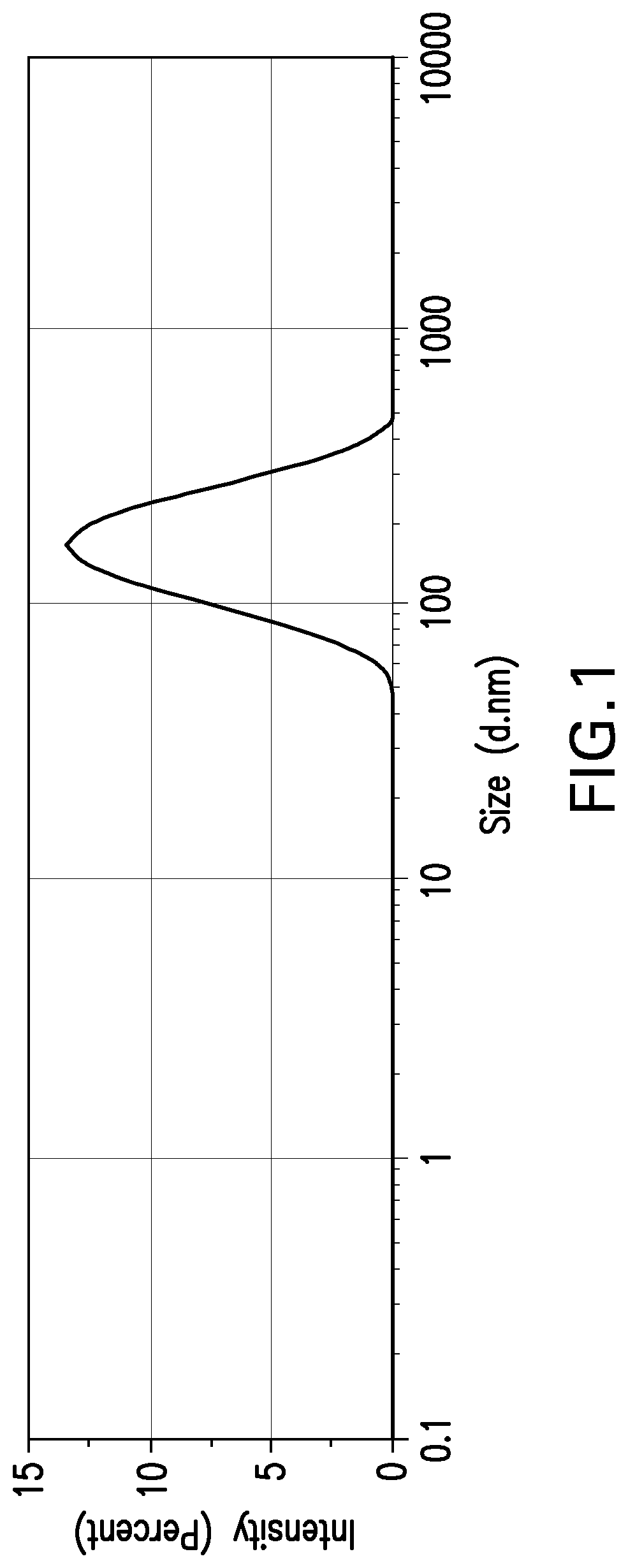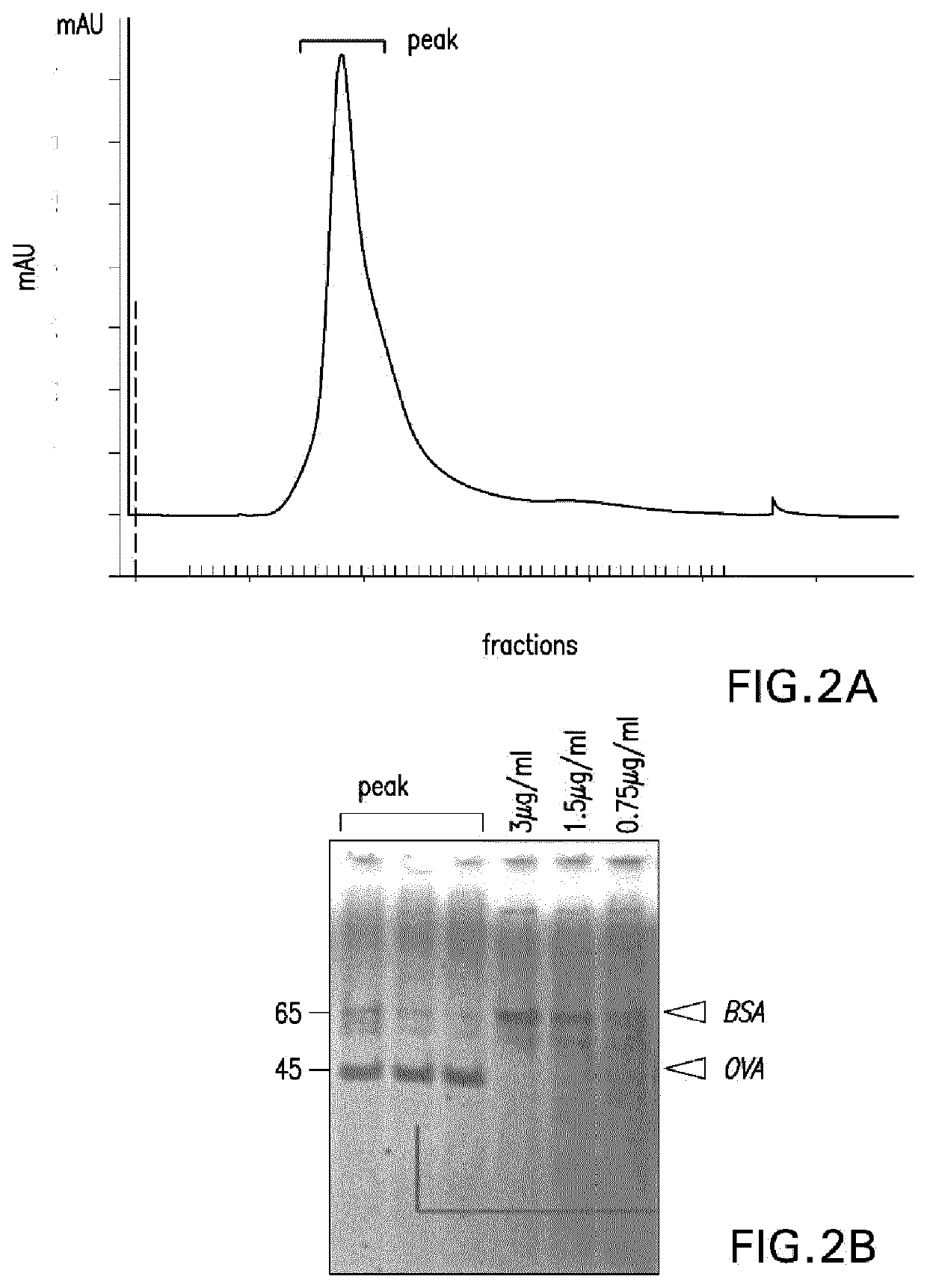Polymersomes comprising a covalently bound antigen as well as methods of making and uses thereof
a technology of polymersomes and antigens, which is applied in the field of polymersomes, can solve the problems of insufficient quantity of membrane proteins for immunization, inefficient methods, and high cost, and achieves the effects of strong humoral immune response, increased antibody production efficiency, and improved efficiency
- Summary
- Abstract
- Description
- Claims
- Application Information
AI Technical Summary
Benefits of technology
Problems solved by technology
Method used
Image
Examples
example 1
ACM Polymersomes Coupling to OVA
[0390]Polymersomes (also called ACMs (artificial cell membranes) prepared with 5% DSPE-PEG(3000)-Maleimide were used to couple OVA through available cysteines. At least one cysteine has been shown to be accessible to solvent (Tatsumi et al., 1997). Coupling conditions were achieved in pH-controlled environment. FIG. 1 shows the Dynamic Light Scattering (DLS) profile from OVA coupled polymersomes which is matching standard features of these exemplary polymersomes of the invention (average (mean) size of the population / collection of polymersomes: 152 nm; pdi: 0.229).
[0391]After extensive dialysis, 100 μl of sample was separated using SEC (FIG. 2A) and 48 fractions of around 180 μl were collected. Pooled fractions corresponding to the peak were lyophilized and resuspended into 500 μl. 20 ul was loaded onto an SDS-PAGE together with some BSA standards (FIG. 2B). A band at the size corresponding to OVA protein was detected suggesting that OVA was successfu...
example 2
BD21-CHO Polymersomes Coupling to HA
[0392]BD21 polymer was modified as described in the methods and the aldehyde modification percentage was estimated to be around 30-40% by NMR. The aldehyde moiety added to the BD21 will react with the primary amines of HA's lysine and arginine residues. After overnight coupling followed by extensive dialysis, the resulting vesicles were characterized. DLS showed a slightly smaller size (average size: 104 nm) and acceptable pdi (pdi: 0.191) (FIG. 3).
[0393]400 μl of the final product were separated by SEC as above (see FIG. 4, light gray trace). Fractions corresponding to the peak were loaded individually onto an SDS-PAGE followed by membrane transfer for immunoblotting. A band with a high molecular weight was detected and seemed to decrease in later fractions outside the peak suggesting that this band corresponds to the conjugated HA. The observed high molecular weight could be due to the numerous polymer molecules coupled to the HA increasing its ...
example 3
Immunizations and Sera Tittering
[0395]C57bl / 6 mice were immunized with the following formulations: a negative control (PBS), free OVA with or without Sigma Adjuvant System (SAS), BD21 encapsulated OVA and BD21 conjugated OVA. All immunizations had a same amount of 4 μg of OVA per injection and per mouse. 21 days after the boost, sera were collected for tittering by ELISA. Free OVA with or without adjuvant was not able to elicit an IgG response. Interestingly, at similar dose conjugated OVA was able to trigger a lot stronger titer response than encapsulated OVA.
[0396]Balb / c mice were immunized with the following formulations: a negative control (PBS), free HA, BD21 encapsulated HA and BD21 conjugated HA. Since some residual free HA was observable in the HA conjugated polymersome sample even after extensive dialysis, pooled fractions of SEC were used for immunizations. All immunizations had a same amount of 100-200 ng of HA per injection and per mouse. Free HA was not able to elicit a...
PUM
| Property | Measurement | Unit |
|---|---|---|
| temperature | aaaaa | aaaaa |
| diameter | aaaaa | aaaaa |
| diameter | aaaaa | aaaaa |
Abstract
Description
Claims
Application Information
 Login to View More
Login to View More - R&D
- Intellectual Property
- Life Sciences
- Materials
- Tech Scout
- Unparalleled Data Quality
- Higher Quality Content
- 60% Fewer Hallucinations
Browse by: Latest US Patents, China's latest patents, Technical Efficacy Thesaurus, Application Domain, Technology Topic, Popular Technical Reports.
© 2025 PatSnap. All rights reserved.Legal|Privacy policy|Modern Slavery Act Transparency Statement|Sitemap|About US| Contact US: help@patsnap.com



